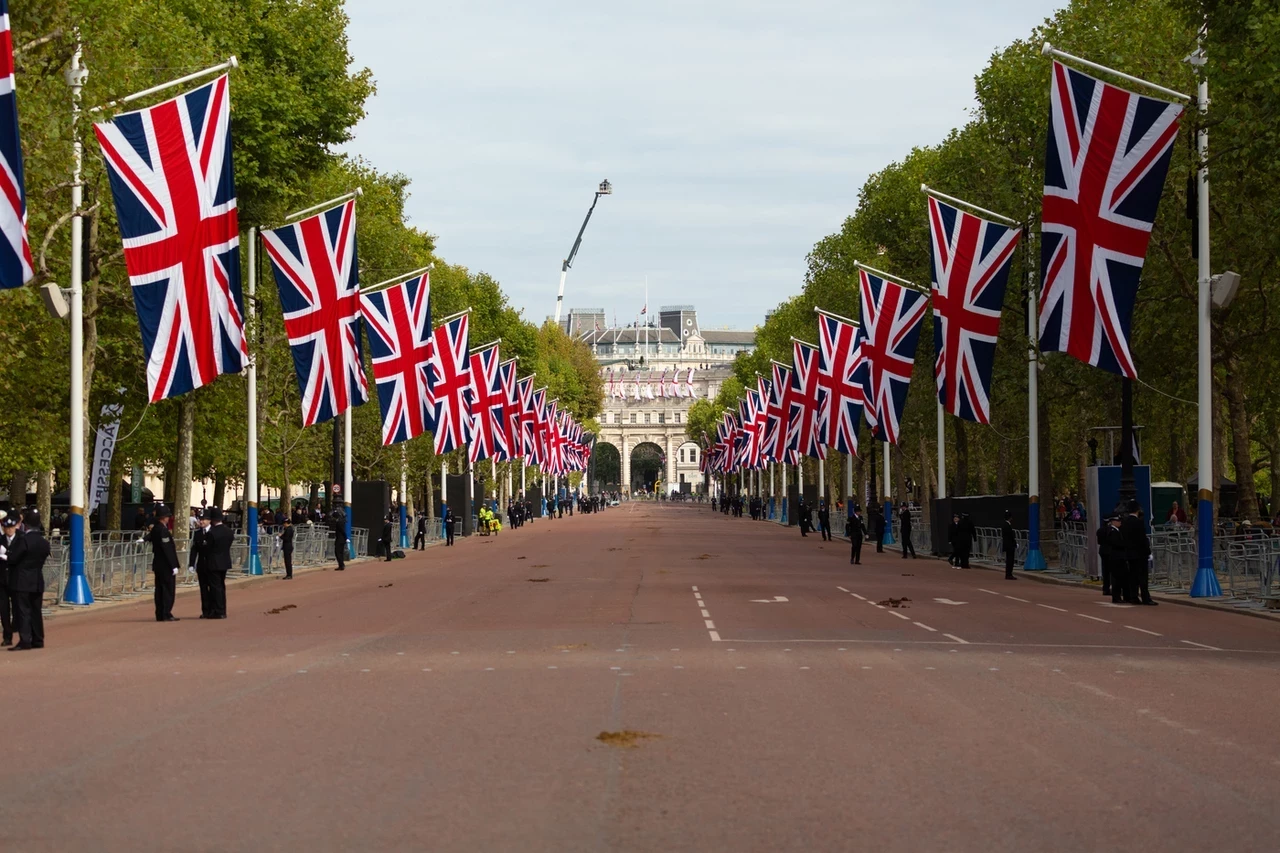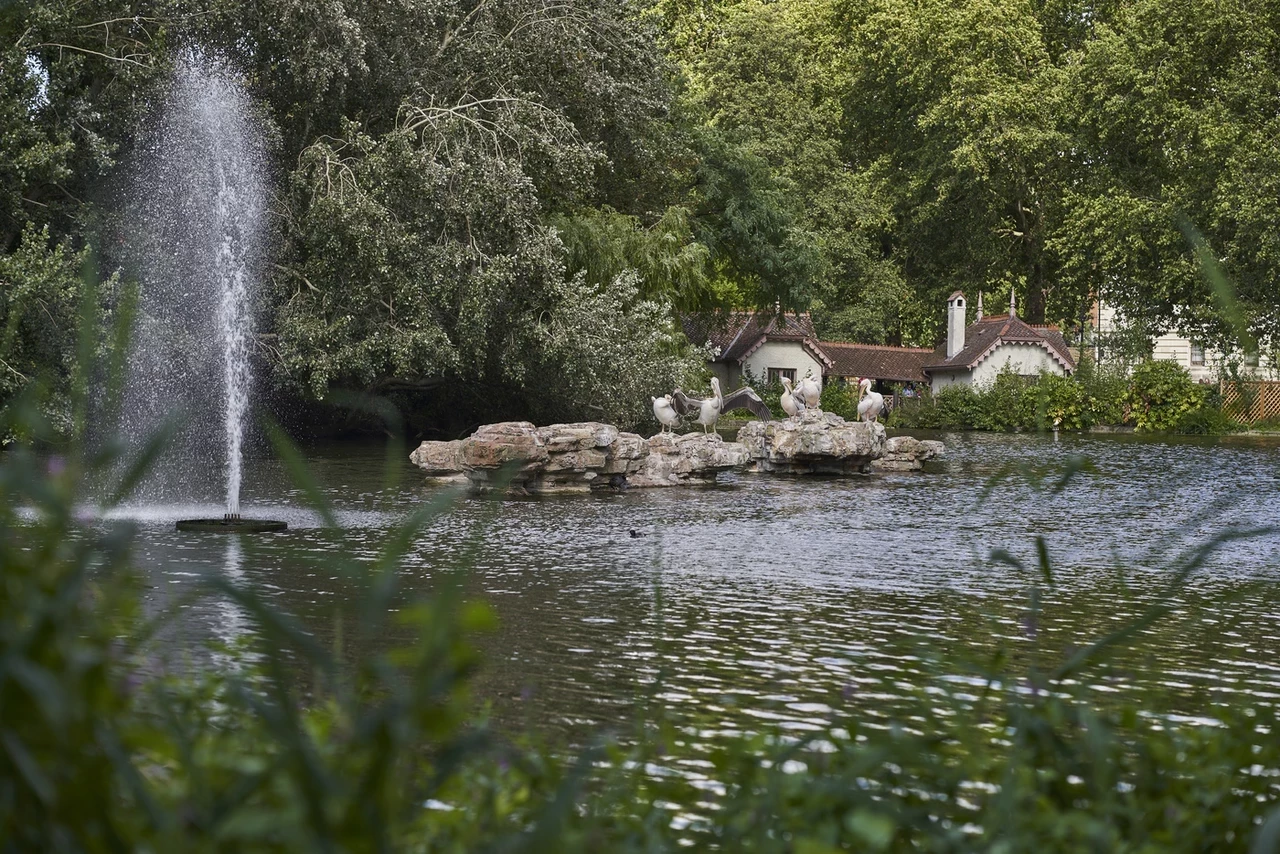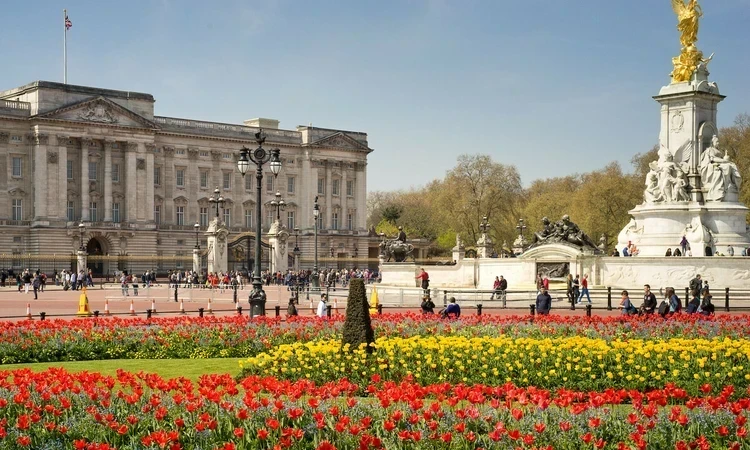
Monuments in St. James's Park
Key information
St. James’s Park is famous for hosting royal ceremonies. From coronations and jubilees to Trooping the Colour and Changing the Guard - it’s no surprise, then, that the park is stuffed with royal and military memorials.
Sitting right outside Buckingham Palace is the colossal statue of Queen Victoria. This was commissioned and unveiled by her grandson, King George V, in 1911.
Another Queen is commemorated along The Mall – Elizabeth, the Queen Mother. She is honoured with a statue that stands next to one of her husband, King George VI.
Overlooking iconic Horse Guards Parade is a moving memorial to the Guardsmen killed in the First World War. The sculptures are made from guns that were captured during the conflict.
In the shadow of Admiralty Arch, meanwhile, is the National Police Memorial, commemorating officers who have died in the line of duty. A book behind a glass window lists their names.
To find out more about these memorials and many others in St. James’s Park, explore the links below.
| Monuments index | |
|---|---|
Admiralty Arch
Commissioned by King Edward VII to commemorate Queen Victoria's death, and designed by Sir Aston Webb and completed in 1912, Admiralty Arch stands majestically at the North east end of The Mall.
This Grade I listed curved stone building has three arches and links The Mall to Trafalgar Square, adjoining the Old Admiralty Building. A Latin inscription along the top reads:
: ANNO : DECIMO : EDWARDI : SEPTIMI : REGIS :
: VICTORIÆ : REGINÆ : CIVES : GRATISSIMI : MDCCCCX :
(In the tenth year of King Edward VII, to Queen Victoria, from most grateful citizens, 1910)

Admiralty Arch plays an important role on ceremonial occasions, with processions such as royal weddings, funerals, coronations and the London 2012 Olympic and Paralympic Games passing through the central arch. The outer arches are used for vehicles and pedestrians.
The inside wall of the northernmost arch has a small protrusion like a human nose. It is at about waist height for anyone on horseback and is traditionally thought to honour the Duke of Wellington, known for having a large nose. Soldiers would rub the nose for good luck as they rode through the arch.
Admiralty Arch was refurbished in 2000 and occupied by the Cabinet Office. In 2012, the building was sold as a 125-year lease and plans were agreed by Westminster City Council to turn the building into a luxury hotel offering views over Buckingham Palace.

Bali memorial
The Bali memorial commemorates the 202 victims of the Bali bombings in 2002. It is located at Clive Steps, along Horse Guards Road.
Unveiled in 2006, by the Prince of Wales and Duchess of Cornwall, this marble globe has 202 carved doves with the names of the victims carved into a stone wall behind the globe. It was designed by Garry Breeze and sculpted by Martin Cook.
Eighty-eight Australians were among those killed and victims also came from Indonesia, Germany, Switzerland, Portugal, Italy, Poland, Greece, the US and Japan.

Boy statue
Designed by Charles Henry Mabey and carved by Robert Jackson in 1863, this Grade II sculpture, entitled the Boy Statue, is a marble figure of a boy, set on a plinth.
Originally a drinking fountain, the water came from the mouths of four fish which collected in shell-shaped basins.
The Boy Statue can be found opposite Queen Anne's Gate on Birdcage Walk.

Captain Cook statue
This statue commemorates the British explorer and navigator, Captain James Cook (1728-79). It is located close to Admiralty Arch and is the first sculpture on entry to The Mall.
This bronze statue set on a stone plinth was designed in 1914 by Sir Thomas Brock, who was also responsible for the Queen Victoria Memorial at the other end of The Mall.
The inscription on the plinth reads:
Captain James Cook / R.N. F. R. S. / Born 1728 Died 1779 / Circumnavigator of the globe explorer of / the Pacific Ocean he laid the foundations of / the British Empire in Australia and New Zealand / charted the shores of New Foundland and traversed / the ocean gates of Canada both East and West / Unveiled by H.R.H. Prince Arthur of Connaught / on behalf of the British Empire League 7th July 1914

Duke of York statue
The Duke of York statue, designed by Sir Richard Westmacott in 1834, is located at the top of the Duke of York Steps, on the north side of The Mall. It features a bronze statue of the Duke of York on a 124ft column designed by Benjamin Wyatt.
It was installed in memory of Frederick William (1763-1827), Commander in Chief of the British Army and second son of King George III. He is probably The Grand Old Duke of York of the nursery rhyme.
The monument cost £21,000 and much of it was raised by soldiers who donated a day's pay.

Graspan Royal Marines memorial
This is a memorial to the Royal Marines who died during the course of two military campaigns: the Boxer Rebellion and the Boer War.
It consists of two bronze figures by sculptor Adrian Jones. They sit on a plinth of Portland stone.
The base is decorated with bronze plaques by Sir Thomas Graham Jackson. They depict the battles and Roll of Honour of the two campaigns.
The memorial was originally positioned in the Cambridge Enclosure in St. James’s Park and was unveiled by The King, The then Prince of Wales, Colonel in Chief of the Royal Marines, on April 25th 1903.
In 1941 the memorial was put into storage to make way for the building of the nearby Citadel. It was moved to its present position on The Mall in 1948.
In 2000, it became the Royal Marines National Memorial and is the focus of the annual ‘Graspan Parade’ – named after the Battle of Graspan during the Boer War.

Guards memorial
Facing the Wellington Barracks, is the Guards memorial - a cenotaph with five life-size bronze figures sculpted by Gilbert Ledward representing the Foot Guards Regiments - Grenadiers, Coldstream, Scots, Welsh and Irish.
Installed in memory of Guardsmen who died in the First World War, it was unveiled in 1926 by the Duke of Connaught, the uncle of King George V. It was designed by H. Chalton Bradshaw. After the Second World War an inscription was added to remember those who died between 1939 and 1945.
The sculptures were made from guns captured in the Frist World War and modelled on real guardsmen. The Irish Guardsman got impatient while he was being modelled and left before the artist had finished, so his legs belong to another soldier. The Memorial was damaged by German bombs during the Second World War and during the repairs a small hole was deliberately left in one of the sculptures.

Horse Guards Parade
Horse Guards Parade is the ceremonial parade ground in St James's Park and is the scene of Trooping the Colour on the King's official birthday in June.
Horse Guards is the building with a clock tower over an archway, and remains the official entrance to St James's and Buckingham Palace. It dates from the eighteenth century and was designed by William Kent, the then Chief Architect to George II.
The building is guarded by two mounted cavalry troopers of The King's Life Guard who are posted outside from 10am to 4pm daily. The Life Guard change takes place here at 11am daily and 10am on Sundays.
During the Trooping the Colour, the central windows are opened so members of the Royal Family can watch the King reviewing his troops below.
In addition to Trooping the Colour, Horse Guards Parade plays host to the floodlit musical spectacular of Beating Retreat by the massed bands of the Household Division over two successive evenings in June.

Next to Horse Guards is:
- Dover House
- the Cabinet and Privy Council Offices
- No. 10 Downing Street, the official residence of the Prime Minister
Also nearby are buildings including:
- the Chancellor of the Exchequer
- the Foreign Office
- Cabinet War Rooms
- Palace of Westminster
There are a number of memorials located at Horse Guards Parade, they are:
- Royal Naval Division Memorial
- Viscount Wolseley Statue
- Earl Roberts Statue
- Lord Kitchener Statue
- Lord Mountbatten Statue

King George VI memorial
Designed by Scottish sculptor, William McMillan, this bronze memorial features a statues of the king dressed in naval uniform, standing on a plinth of Portland stone.
It was unveiled by the late Queen Elizabeth II in 1955.
The memorial is located on the north west side of The Mall. In 2009, a statue dedicated to his wife Elizabeth, the Queen Mother was erected nearby.

The lake and The Blue Bridge
The Blue Bridge offers spectacular views across St. James's Park Lake to Buckingham Palace to the west and Horse Guards Parade, Big Ben and the London Eye towards the east.
The low-arched concrete bridge is the third to span the lake. The first was designed by John Nash which was replaced by an iron suspension bridge in 1857. The current bridge dates from 1957.
As well as the spectacular views, The Blue Bridge is an excellent spot to view St. James's Park's waterfowl.

The Mall
The Mall is a grand processional route in honour of Queen Victoria, which has seen innumerable historic Royal processions including coronations, state openings of Parliament and state visits.
During King Charles II reign, in 1660 he ordered the redesign of St. James's Park and this included a centerpiece - a straight canal, 2,560ft long and 125ft wide, lined on each side with avenues of trees.
The name is derived from Pelle Melle, a game introduced by King Charles I which was traditionally played in St. James's Park. Traffic was permitted on The Mall in 1887.
Today, The Mall plays an important part in ceremonies such as Changing the Guard, Trooping the Colour and also royal events such as weddings and funerals, and the recent Jubilee celebrations.

National Police Memorial
At the corner of The Mall and Horse Guards, stands the National Police Memorial, commemorating police officers killed in the course of duty in the UK.
Designed by Lord Foster and Per Arnoldi, it was unveiled in 2005 by HM The Queen. The memorial takes the form of a black granite clad tablet with glass chamber containing a book listing the names of those killed, the pages of which are turned every day by the Police Memorial Trust.

Queen Mother memorial
Standing next to the bronze statue of her husband, King George VI, this national memorial to The Queen Mother, who died in 2002 aged 101, was unveiled by the late Queen Elizabeth II in February 2009.
The bronze statue by Philip Jackson, shows the Queen Mother at the age of 51, when she was widowed.
The memorial cost £2m and was funded by a £5 coin, produced by the Royal Mint to celebrate the Queen's 80th birthday.

Queen Victoria memorial
The Queen Victoria Memorial is located in front of Buckingham Palace and comprises the Dominion Gates (Canada Gate, Australia Gate and South and West Africa Gates), the Memorial Gardens and a vast central monument commemorating the death of Queen Victoria in 1901.
The monument is 25 metres high and uses 2,300 tonnes of white Carrara marble. As well as Victoria, there are statues representing courage, constancy, victory, charity, truth and motherhood.
The central monument, created between 1906 and 1924, is by Sir Thomas Brock, but the whole design, including the Memorial Gardens, was conceived by Sir Aston Webb. The Memorial was formally unveiled by King George V in 1911.
The gates, piers, balustrades and retaining walls of the Memorial Gardens are all protected landmarks.

The Memorial Gardens
The Memorial Gardens were created in 1901 as part of Sir Aston Webb's overall design for a memorial to Queen Victoria after her death that year.
The formal flowerbeds are laid out in a semi-circular design around the central memorial and are a familiar sight during the many of the famous processions and ceremonies that take place in this area.
The planting schedule follows a traditional seasonal pattern that is repeated each year. Each planting takes approximately two weeks and involves up to ten staff.
Replanting of the beds in summer requires approximately 22,500 plants, including geraniums, spider plants, salvias and weeping figs. Scarlet geraniums are used to match the tunics of The Queen's Guard at Buckingham Palace.
In winter time the beds are filled with about 50,000 yellow wallflowers and red tulips.

Royal Artillery Memorial
This memorial was erected in memory of the 1,083 Royal Artillery soldiers who were killed in the Boer War. Designed by William Robert Colton, it is located on the south side of The Mall.
The memorial features a bronze winged figure of Peace subduing a horse that represents War. The bronze figure stands on a pedestal of Portland stone and there are bronze plates listing the names of the dead.
The inscription on the memorial reads:
Erected by the officers and men of the Royal Artillery in memory of their honoured dead. South Africa. 1899-1902.
The memorial was unveiled by the Duke of Connaught, uncle of King George V, in 1910.

Royal Naval Division memorial
The Royal Naval Division Memorial is dedicated to the 45,000 members of the Royal Naval Division who died during the First World War. The memorial is located in the northwest corner of Horse Guards Parade next to Old Admiralty Buildings.
The Royal Naval Division was formed in 1914 by Sir Winston Churchill as an intervention force, fighting in the First World War at Gallipoli and on the Western Front before being disbanded in 1919.
The memorial was commissioned by surviving Royal Naval Division members and takes the form of a stone obelisk and fountain.

It includes an inscription by Rupert Brooke, who died on active service with the Royal Naval Division in the Dardanelles in 1915. It reads the sonnet:
Blow out you bugles, over the rich dead / There's none of these so lonely and poor of old / But, dying has made us rarer gifts than gold. These laid the world away: Poured out the red / Sweet wine of youth; gave up the years to be. / Of work and joy, and that unhoped serene / That men call age: And those who would have been / Their sons, they gave their immortality.
It was designed by Sir Edwin Lutyens and unveiled at Horse Guards in 1925 by Sir Winston Churchill, alongside Sir Ian Hamilton – the commander of the Gallipoli campaign.
The memorial was removed in 1939 when the Admiralty Citadel was built between Horse Guards Parade and The Mall and later installed at the Royal Naval College at Greenwich in 1951.
It returned to Horse Guards and was re-dedicated in 2003 on Beaucourt Day (the Regimental Day on November 13 marking the successful attack on Beaucourt-sur-L'Ancre in the Battle of the Somme in 1916).

Tiffany fountain
At the centre of St. James’s Park lake is the Tiffany Fountain. The fountain sends a six metre (20ft) plume of water straight into the air, enhancing the special views across the park to Buckingham Palace, Whitehall and Horse Guards Parade.
On special occasions the jet is illuminated at night, in any one of a rainbow spectrum of colours.
The Tiffany Fountain was restored to the lake in 2011. It re-creates an earlier fountain which was installed at Pelican Rock in 1966, and removed thirty years later due to wear and tear.
Tiffany Fountain facts
- The fountain helps provide a better habitat for wildlife in the lake. The process of sending water into the air improves the lake’s water quality and is known as aeration.
- The jet can reach a height of eight metres and is aligned to the Buckingham Palace balcony.
- The volume of water recycled continuously from the lake through the jet could fill your bath at home in just 24 seconds.
- A clever wind speed sensor is located at the end of Duck Island to reduce the jet height in strong winds. This keeps the fountain operating and avoids the pelicans having a cold shower in winter.
- The lighting system uses low energy LEDs and is automatically switched off during the day.
The fountain was made possible by a generous gift from The Tiffany & Co. Foundation.







